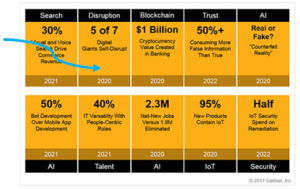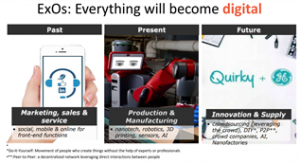Part 2 – Dawn of DX Economy & Rise of EXOs, How can Service Management Complement?
Publish Date: August 23, 2018‘As the march to becoming a digital native enterprise continues, organizations and industries will be destroyed and rebuilt……The goal is to innovate and scale the business at an order of magnitude greater than traditional business’ [1]
As we continue from Part 1 of this blog and when we look at various predictions from leading analysts; we see a linkage. A linkage on enablers for Organizations towards convergence of DX (Digital Transformation), EXO (Exponential Organization), and SM (Service Management).
One of the ‘Top 10 Strategic Predictions for 2018 & Beyond [3]’, Gartner refers to Self-disruption by Digital giants. Refer Figure 1 below –
“By 2020, five of the top seven digital giants will willfully “self-disrupt” to create their next leadership opportunity [3]” Figure 1 |
|
| Gartner thus details – ‘In doing new things, digital giants — such as Alibaba, Amazon, Apple, Baidu, Facebook, Google, Microsoft and Tencent — are likely to run into situations where their influence has grown so large that it is difficult to create new value scenarios. This ultimately leads to self-disruption. In a self-disrupting strategy, disruption arises as intentional intent to get there first, even if it is necessary to disrupt yourself. While this can be risky, risk of inaction can be even higher’ |
An interested read here in this context is from HBR’s article [4] – “Why Microsoft is willing to pay so much for GitHub?” and is attributed to perception of VALUE, arising either from a Financial perspective or Strategic perspective. In this context, the article further goes on to attribute a strategic context which would enable Microsoft get access to legions of developers who use GitHub’s code repository products on a daily basis (…..and quotes further insights into the deal)
Onto the Convergence of the Worlds of Trio – The DX Economy, EXOs and Service Management
 |
||
| On DX & DX Economy –By 2018, 35% of IT resources will be spent to support the creation of new digital revenue streams and by 2020 almost 50% of IT budgets will be tied to digital transformation initiatives [6] | In the world of EXOs – Everything will become Digital [5]– |
Service Management: Why the As-a-Service Model works well for Digital Transformation? IoT involving digitization of physical world, Customer Service Considerations key for IoT, offers a great avenue for application of Service Management practices. With IoT, anything and everything connected to Internet, process and technology support is needed along with a customer centric focus |
| ‘While the digital transformation of industries will be profound, we must keep in mind that it will have wider economic and social impact, too, as with previous revolutions driven by steam and coal, electricity and computers’ – Pierre Nanterme, French business executive currently Chairman and CEO of Accenture. | ||
We thus see a close linkage between the trio. So, what is key for businesses is Adaption and Adoption. Adaption and Adoption to –
- Adapting to Change
- Step-up from Legacy to Digital
- Adapting to NextGen
- SMAC powered DIY Tools as Enablers could greatly enhance and complement the journey
1. Adapting to Change
Change is inevitable in today’s world of Disruptive Innovation and Speed of Change. The trio playing a major convergence aspect for businesses, key is the ability of adaption to XaaS – Anything and Everything-as-a-Service model and the Service Thinking as an essential capability along with other capabilities for OCM – Change capability, Service Capability, Organizational Capability.
An enabler for this at Enterprise level for businesses is centralized Change Management, Knowledge Management and the single source of truth, Configuration Management. Change involves adaption of policies and procedures for setting these centralized processes for the Organization and tracking and monitoring them through a Governance model.
2. Step-up from Legacy to Digital
Majority of large enterprises today still contain legacy platforms and hence retiring such legacy systems though vital could often be impractical and get excessively costly. At the same time keeping them around might serve as a reference, but will slow down the innovative, fast-paced parts of the business that drive competitive differentiation and get to the aspired edge.
It is here the rationalization of Applications, Technology, Platforms, Infra CIs, etc, as deemed fit and suitable for Organizations, could greatly enhance achieve the economies of scale and SMAC powered business outcomes. Though it could have certain limitations, worth a try in today’s pace of rapid technological advancements.
3. Adapting to NextGen – SIAM, AI etc
Organizations are seeking to harness new technologies, and rethinking their business models. As many businesses are trying to decide how to respond to threats and opportunities arising from digitization, organizations are demanding service management departments to quickly and flexibly offer services that best equip a modern workforce and a customer delight. Organizations have been forced to constantly add new software modules to address gaps including capabilities such as configuration management, asset discovery, service cost reporting and problem management to name a few. As a result, Service Management apps and Service Catalog tools are rapidly evolving to enable business agility in today’s digital world.
To meet challenges and embrace change, Organizations need to find ways to look at business enablers that can propel and help sustain growth. SIAM – Service Integration and Management along with Business Performance Management will greatly help decentralize and benchmark respectively to move ahead of the curve. One other enabler in today’s times of ZMOT and Cust First in Digital Age, is to give the consumer the freedom and flexible landscape of products and services to choose from the digital catalogs for digital age.
IT service management (ITSM) is changing: take the idea of service operation and putting in a service ticket; With and AI (Artificial Intelligence) your computer will know about an issue before you do and will either submit a ticket or walk you through a fix. Having AI handling these low level, low complexity demands will leave ITSM to focus on larger, more complex items such as processes, policies, governance etc and how everything fits together. This won’t happen overnight but organizations will need to attain this level
4. SMAC powered DIY Tools as Enablers
In today’s digital age, SMAC powered devices and services are most common. ITSM tools with these features would be a great boon to businesses.
ServiceNow was positioned as Leader in Gartner’s Magic Quadrant for ITSM tools. ServiceNow refers to incorporation of future of ITSM into its product that is propelled by Virtual Agents, Artificial Intelligence and Machine Learning. Along with other ServiceNow predictive analytics and automation capabilities, models that automatically categorize, prioritize and route tasks in the service desk can be created. And this would help find early indicators of problems to prevent issues, benchmark services and predict performance. With the time saved, organizations can now focus on work that matters most. SNOW launched Intelligent Automation Engine to bring ML to work every day. 1. ServiceNow acquired DXContinuum and supplemented it with acquisition of Qlue to deliver intelligent automation [7]
Summary/Conclusion
Forbes prediction would manifest the reality. More than wait and watch, be the first to take the leap.
By 2020, we expect that the ‘new normal’ operating model will be customer- and context-centered. That is, companies will change the way they interact with their customers based on the context of the exchange. They will offer a seamless omnichannel experience, through a smart balance of human and machines.- Financial services technology 2020 and beyond: Embracing disruption
Lakshmi Nanduri – Program manger @YASH Technologies
Lakshmi Nanduri
References
- https://www.cio.com/article/3104144/it-service-management/the-future-of-it-service-management-in-a-world-of-digital-transformation.html
- https://www.idc.com/events/futurescapes
- https://www.gartner.com/newsroom/id/3811367
- https://hbr.org/2018/06/why-microsoft-is-willing-to-pay-so-much-for-github
- Yuri van Geest at WebTomorrow talking about Why new organizations are 10 times better, faster, cheaper than yours and What You can Learn From Them
- https://www.forbes.com/sites/gilpress/2015/12/06/6-predictions-about-the-future-of-digital-transformation/2
- https://servicematters.servicenow.com/2017/08/15/4-years-row-servicenow-named-leader-gartner-magic-quadrant-service-management-tools/

















